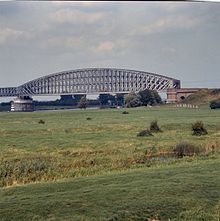Culemborg railway bridge
Coordinates: 51 ° 57 ′ 38 " N , 5 ° 12 ′ 48" E
| Culemborg railway bridge | ||
|---|---|---|
| use | Railway bridge | |
| Crossing of | Lek | |
| place | Culemborg | |
| construction |
Truss bridge arch bridge |
|
| overall length | 670 m | |
| Longest span | 154.4 m | |
| Clear height | 12.66 m / 9.80 m at HSW | |
| start of building | 1863 | |
| opening | 1868/1885 // 1983 | |
| planner | Gerrit van These | |
| location | ||
|
|
||
| Culemborg Bridge in April 1975 | ||
| View from the south | ||
The Culemborg railway bridge ( Dutch Spoorbrug Culemborg ; formerly also Kuilenburg bridge , Dutch Kuilenburgse spoorbrug ) leads the Utrecht-'s-Hertogenbosch-Boxtel railway line in the Netherlands from the province of Utrecht over the Lek to Culemborg in the province of Gelderland .
The Kuilenburg Bridge, opened in 1868, was the first truss bridge with semi-parabolic girders and at the same time the first steel bridge and the one with the largest span of all bridges of its kind at the time (except chain and suspension bridges ).
In 1983 it was replaced by a steel arch bridge with a suspended track below.
Truss Bridge (1868)
The development of the Dutch rail network has long been hampered by the broad estuary of the Rhine. It was not until the 1860s that railway bridges could be built over rivers of this size. To make matters worse, the bridge was supposed to cross the river in a bridge field without piers , so as not to impede navigation and to avoid damming caused by ice drift and the flooding caused by it. The new bridge planned by the Dutch engineer Gerrit van These therefore had a main opening with a span of 154.4 m, a secondary opening for shipping during the construction of the main bridge of 80 m and seven foreshore bridges on the north side with 60 m each. On the southern bank, a brick arched bridge across the embankment made the connection to the embankment.
The main opening was spanned by a steel truss bridge with two semi-parabolic girders with a center distance of 9.26 m, which were 20.5 m high in the middle. Their clear height was 12.66 m to allow the majority of the Rhine ships to pass. The state granted a total of 133,574 guilders for modifications to the masts for 592 larger ships . The side opening and the approach bridges were truss bridges with parallel chords.
The large superstructure of the main opening was not only the first application of the semi-parabolic girder for large spans, but also the first bridge to be built from mild steel produced in the Bessemer pear . It was made by the Duisburg bridge construction workshop Johann Caspar Harkort based on a tender .
The groundbreaking ceremony took place on January 16, 1863. In December 1865 the pillars were ready. The construction of the bridge began with the approach bridges and the 80 m opening for shipping, and finally the main bridge was installed in 1867. The last rivet was driven in on November 25, 1867. On April 1, 1868 the bridge was opened to traffic.
The bridge was built as a two-track bridge, but the second track was not moved until 1885. In 1913 it was reinforced because of the increased traffic loads. It survived the Second World War without major damage.
Tied Arch Bridge (1983)
In the 1980s, the bridge was no longer able to cope with the increased traffic loads. It was therefore replaced in 1983 by a modern tied arch bridge in which the roadway was designed as a tension band that takes over the compressive forces of the two arches designed as steel hollow boxes . The side opening and the approach bridges were replaced by reinforced concrete bridges .
It stands at river kilometer 939.80. The official bridge clearance is now 9.80 m at HSW .
Web links
Individual evidence
- ↑ Spoorbrug Culemborg with a plan and a side plan, on Rhine index
- ↑ a b c d e Hans Pottgießer: Railway bridges from two centuries . Birkhäuser Verlag, Basel / Boston / Stuttgart 1985, ISBN 3-7643-1677-2 , pp. 182-185.
- ↑ Photo of the old and the new bridge side by side. On Railway bridges: Op ijzeren due
- ↑ Rhine index



